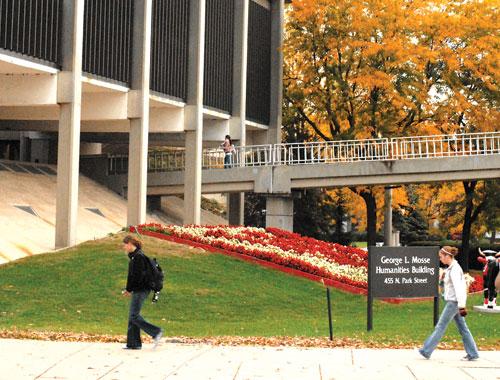As a journalism student, I used the Humanities bridge daily. But even I can understand the pedestrian bride is not worth the money to repair it.
The cost to repair the bridge is $1.5 million and with a safe alternative to cross the street, the money can be used elsewhere. I do apologize to all the Vilas and Humanities students who have to wait 26 seconds for the light to change.
Understanding the decision was not based on the recent budget cuts, however, makes the pill easier to swallow.
According to Bill Elvey, associate vice chancellor of Facilities Planning & Management, the construction of the Humanities bridge falls under the Capital Planning and Management Department, which is in the umbrella of the FP&M but funding is allocated differently.
The move to take down the bridge was a business decision and not directly related to the budget cuts.
As far as what needs to be accomplished before $1.5 million is spent repairing a bridge, there are more important priorities.
“I have $300 million worth of back log on capital renewal and referred maintenance,” Elvey said. “That means I have to do health and safety things, I have to do routes and air condition systems. Those are way higher on the priority list than a pedestrian bridge, which, in theory, you don’t actually even need.”
Air conditioning is important and safety repairs are usually mandatory. Personally, I would rather sit in an air-conditioned lecture hall and not have tiles fall on my head before I’d want a quicker way to cross University Avenue.
But the destruction of the bridge does raise important budgetary questions. While the Humanities bridge was not directly related to the millions of dollars cut from UW, there are operational expenses that will be compromised.
“Our operating budget was cut $2.9 million,” Elvey said. “In our case we made a conscious decision to reduce some custodial service level in some of our newer buildings.”
According to Elvey, they were trying to maintain a higher level of service in the new buildings and now will reduce service to the level of older buildings.
“Typically if you can keep the building at a higher level of custodial service they will maintain over time. It is like waxing your car more often, the paint finish will last longer,” Elvey said.
The bridge is now a distant memory. We should stop mourning its loss and begin to recognize other problems that are surfacing due to budgetary cuts. Reducing maintenance is a slippery slope towards poor aesthetics and structural deterioration.
Mackenzie Krumme ([email protected]) is a junior majoring in journalism and international studies.














